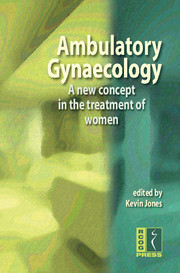Book contents
- Frontmatter
- Contents
- ABOUT THE AUTHORS
- ABBREVIATIONS
- PREFACE
- Chapter 1 Introduction
- Chapter 2 Anaesthesia and analgesia for outpatient gynaecology
- Chapter 3 Colposcopy services
- Chapter 4 Abnormal uterine bleeding
- Chapter 5 Endometrial ablation
- Chapter 6 Urogynaecology: urinary incontinence and genital prolapse
- Chapter 7 Infertility
- Chapter 8 Early pregnancy units and emergency gynaecological services
- Chapter 9 Pelvic utrasound and interventional radiology
- Index
Chapter 7 - Infertility
Published online by Cambridge University Press: 05 June 2014
- Frontmatter
- Contents
- ABOUT THE AUTHORS
- ABBREVIATIONS
- PREFACE
- Chapter 1 Introduction
- Chapter 2 Anaesthesia and analgesia for outpatient gynaecology
- Chapter 3 Colposcopy services
- Chapter 4 Abnormal uterine bleeding
- Chapter 5 Endometrial ablation
- Chapter 6 Urogynaecology: urinary incontinence and genital prolapse
- Chapter 7 Infertility
- Chapter 8 Early pregnancy units and emergency gynaecological services
- Chapter 9 Pelvic utrasound and interventional radiology
- Index
Summary
Introduction
Infertility is defined by World Health Organization as the diminished or absent ability to conceive or produce an offspring. Most couples plan on having a baby and for the majority this happens within a reasonable length of time. For one in six couples this does not occur, however, and help may be needed to assess their condition and initiate treatment.
Within the past two decades, owing to notable advances, the majority of infertile couples can be offered some form of treatment that improves their chance of conceiving. A decision on what form of treatment is most suitable, however, requires a diagnosis, which involves various investigations and examinations. On reaching a diagnosis appropriate counselling, prognosis and treatment can be offered. Ideally a diagnosis should be reached in as short a time as possible.
Management of the newly referred infertile couple is often frustrating for the patient, general practitioner and clinician alike for the following reasons:
• There is often a delay in the waiting time from referral to consultation, regardless of the cause of infertility
• At the first consultation, a working diagnosis or prognosis is difficult to establish because the results of all essential preliminary investigations are often not available.
Almost all gynaecologists see and investigate infertile women or couples, but the Royal College of Obstetricians and Gynaecologists has recommended that optimal care is best provided in a dedicated environment – a fertility clinic.
- Type
- Chapter
- Information
- Ambulatory GynaecologyA New Concept in the Treatment of Women, pp. 82 - 94Publisher: Cambridge University PressPrint publication year: 2008

